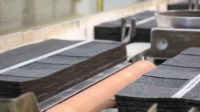One of the most noteworthy success stories in sustainable roofing has been the growth in recycling of asphalt shingles. Each year, more and more shingles are recycled instead of being dumped into local landfills. In addition to saving valuable resources and reducing the environmental burden on landfills, shingle recycling offers solid economic benefits for roofing contractors, and helps homeowners make a positive environmental contribution when it’s time to replace their existing roof.
The biggest driver behind shingle recycling has been the emergence of a network of recyclers across the country capable of accepting and processing shingles removed from existing roofs. Shingle recycling is now available across the United States, with almost all major metropolitan areas being served by a number of recycling firms. Finding your local recycling options has never been easier with the introduction of a new website sponsored by the Construction Demolition and Recycling Association, which features an extensive recycling search tool that provides you all of the shingle-recycling options for your market.
To find shingle recyclers near you, just visit www.shinglerecycling.org and enter your state, city or zip code. As the database grows, it’s likely that you’ll find at least a half dozen or more recyclers capable of serving your market. Next, take some time to review the following shingle-recycling tips courtesy of the Asphalt Roofing Manufacturers Association (ARMA)* to help you make the most of recycling for your business and your customers:
- Using www.shinglerecycling.org or other sources, locate recyclers in your local area.
- Check out the reputation and capability of each recycler just like any other supplier or subcontractor. Once again, the shingle-recycling website may provide helpful information.
- Keep shingles clean of other debris like wood and metal, or separate materials within the load. But leave staples and nails within the shingles, as they will be pulled out with strong magnets during the recycling process.
- Call your recycler before dropping off to determine the specific procedures at the site.
- Integrate shingle recycling into your sales and marketing efforts. Tell your customers that you’re recycling their used shingles, and share your recycling success with customers.
- Provide your customers with a written report verifying the amount of shingles recycled. Many recyclers will report a percentage of materials recycled, including some who use green-building standards for reporting.
Finally, start saving money by recycling. Recycling is generally less expensive than using a landfill, may result in less travel time to and from the site, and typically has shorter lines than a landfill. Although recycling costs vary, it’s almost always cheaper than landfilling and can often be made even less expensive if you separate materials properly. In some cases, recycling is free, which can save you 100 percent of dump fees.
So, if you’re not recycling asphalt shingles today, I encourage you to get started. You’ll save money and provide your customers with one more reason that you’re a leader in your market.
*Excerpted from “Asphalt Shingle Recycling Do’s and Don’ts,” which is available at www.shinglerecycling.org and www.asphaltroofing.org.






Report Abusive Comment